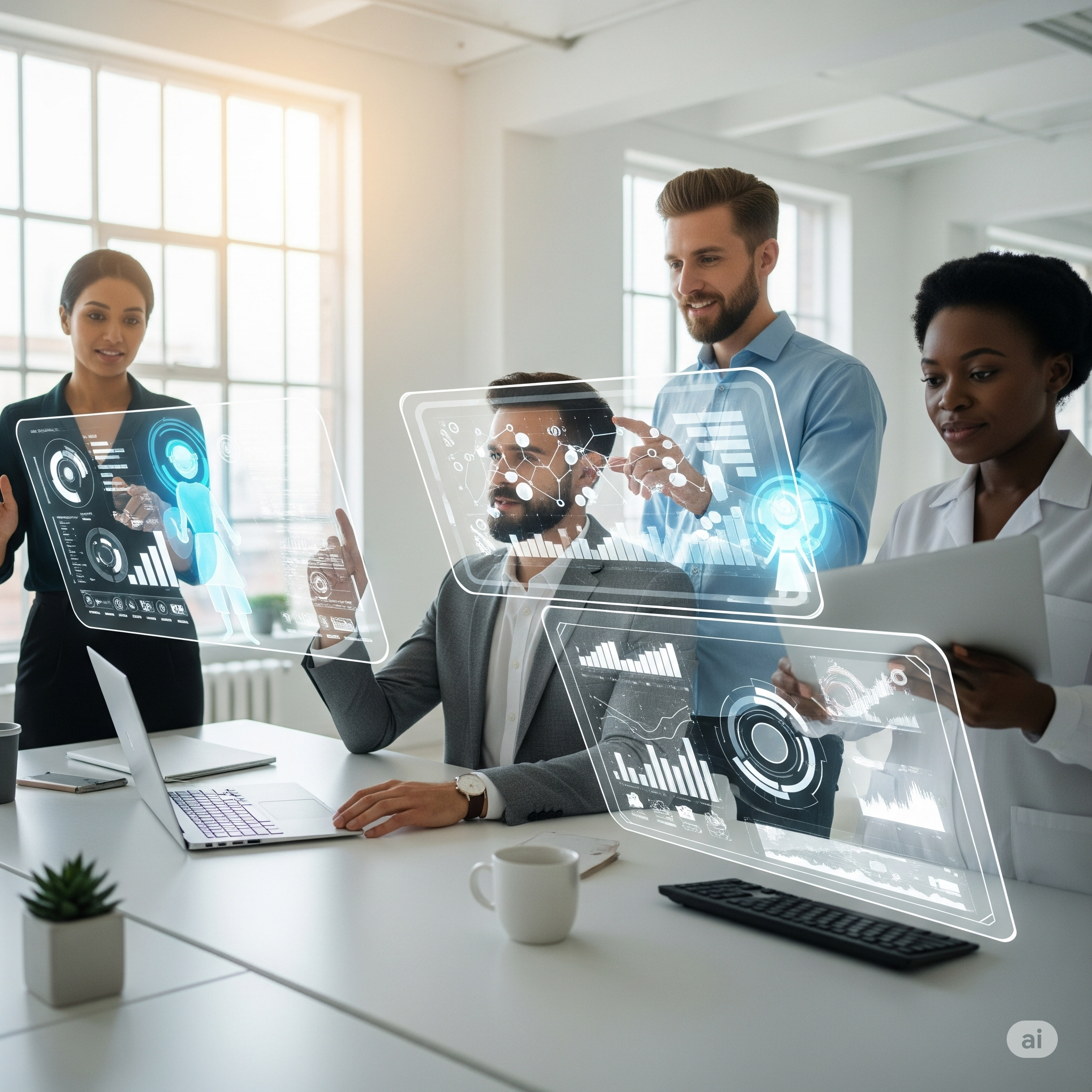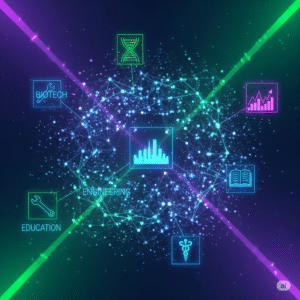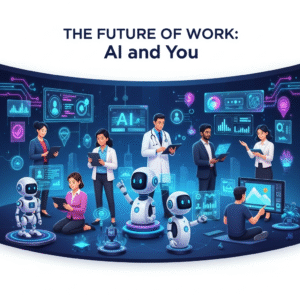The relentless march of Artificial Intelligence has already reshaped our professional landscapes in profound ways. From automating mundane tasks to providing unprecedented insights, AI’s integration into the workplace is no longer a futuristic concept but a daily reality. As we stand in mid-2025, looking ahead to the next decade, the future of AI in work promises an even more symbiotic and transformative relationship between humans and intelligent machines. This isn’t merely about job displacement; it’s about the evolution of roles, the augmentation of human capabilities, and the birth of entirely new industries.
The future of AI in work will be defined by its seamless integration into core business functions, turning raw data into strategic decisions and significant profits. This article will delve into specific predictions, real-world examples, and actionable insights to help professionals and businesses navigate this exciting, yet challenging, era.
The Dawn of Hyper-Personalized Workflows and Intelligent Assistants
By 2035, the concept of a “one-size-fits-all” workflow will be a relic of the past. AI will power hyper-personalized work environments, adapting to individual preferences, strengths, and even emotional states to optimize productivity and well-being. Imagine an intelligent assistant that not only manages your calendar and emails but also proactively surfaces relevant information for meetings, drafts initial responses based on your communication style, and even suggests optimal times for focus work or breaks, all informed by your biometric data and past performance.
This level of personalization will extend beyond individual tasks. Teams will leverage AI to dynamically allocate resources, identify skill gaps, and even predict potential bottlenecks in projects, enabling proactive adjustments. The secondary keyword, AI workplace predictions, truly emphasizes this shift towards a more anticipatory and adaptive work environment. AI will become the invisible architect of efficiency, freeing up human cognitive capacity for higher-order problem-solving, creativity, and strategic thinking.
AI as the Ultimate Business Intelligence Engine
The core of AI’s transformative power in professional life lies in its ability to process, analyze, and interpret vast quantities of data at speeds and scales impossible for humans. This capability makes AI an unparalleled business intelligence engine, enabling organizations to gain deeper insights and make more informed decisions than ever before. We will see the future of AI in work manifest significantly in predictive analytics, prescriptive insights, and automated report generation.
Instead of merely reporting on what has happened, AI will increasingly tell us what will happen and, crucially, what should be done. This moves us beyond traditional business intelligence into a realm of proactive, AI-driven strategy. For instance, sales teams will use AI to predict customer churn with remarkable accuracy, allowing for targeted retention efforts. Marketing departments will leverage AI to identify emerging trends and personalize campaigns at a granular level, maximizing ROI. Financial institutions will employ AI for sophisticated fraud detection and risk assessment, safeguarding assets and streamlining operations.
Case Study 1: Revolutionizing Supply Chain with Predictive AI
Consider “Global Logistics Solutions,” a hypothetical but representative company facing complex supply chain challenges. Before 2025, their operations were plagued by unpredictable delays, inventory imbalances, and reactive decision-making. Their business intelligence systems, while robust, primarily provided historical data analysis.
Enter AI. Global Logistics Solutions implemented an AI-powered predictive analytics platform that integrates data from weather patterns, global economic indicators, geopolitical events, supplier performance metrics, and real-time shipping data. This platform, built using tools like Tableau (for visualization of complex data, available at https://www.tableau.com/) and custom machine learning models, began to forecast demand fluctuations and potential disruptions with over 90% accuracy.
Sarah Chen, their Head of Operations, explains: “The future of AI in work for us means moving from reactive firefighting to proactive optimization. Our AI system now predicts a potential Suez Canal blockage three weeks in advance based on a confluence of satellite imagery, shipping schedules, and geopolitical news feeds. This allows us to reroute shipments, adjust inventory levels, and inform clients well ahead of time, saving millions in potential losses and significantly boosting customer satisfaction. It’s transformed our operational efficiency and responsiveness.”
The Evolution of Human-AI Collaboration
The next decade will see a deepening of human-AI collaboration, shifting from simple tool usage to genuine partnership. AI will serve as an extension of human intellect, handling the computationally intensive aspects of a task while humans provide creativity, ethical judgment, and nuanced understanding. This collaboration is central to the future of AI in work.
For instance, in legal professions, AI will rapidly sift through millions of legal documents to identify precedents and relevant cases, allowing lawyers to focus on crafting arguments and client interaction. In healthcare, AI will assist doctors in diagnosing rare diseases by analyzing patient data against global medical knowledge, augmenting human diagnostic capabilities. This isn’t about AI replacing doctors or lawyers; it’s about making them vastly more efficient and effective.
AI-Powered Tools Transforming Business Operations
The landscape of AI tools available to businesses will continue to expand and mature, becoming more accessible and integrated. Here are a few examples of tools and their potential impact:
- ChatGPT (or similar large language models from https://chat.openai.com/): Beyond content creation, these tools will become sophisticated “thought partners,” assisting in strategic brainstorming, generating complex reports, summarizing vast amounts of information, and even acting as intelligent interfaces for internal knowledge bases. OpenAI’s continued development will see these models become even more adept at understanding context and generating nuanced responses.
- Microsoft Power BI (get started at https://powerbi.microsoft.com/en-us/): This platform will continue to evolve its AI capabilities, offering more advanced natural language queries, automated data insights, and prescriptive recommendations. It will empower non-technical users to perform sophisticated data analysis and create interactive dashboards with ease.
- MonkeyLearn (explore their solutions at https://monkeylearn.com/): Specializing in text analysis and machine learning, MonkeyLearn will enable businesses to automatically process customer feedback, analyze social media sentiment, and categorize unstructured data, providing invaluable insights into market trends and customer satisfaction.
- Zapier (learn about automation at https://zapier.com/): As a leading automation platform, Zapier will become even more crucial for integrating various AI tools into existing workflows, creating seamless, automated processes across different applications, from lead generation to customer support.
- Tableau (official site: https://www.tableau.com/): While already a leader in data visualization, Tableau will enhance its AI capabilities to offer more intelligent data preparation, automated discovery of patterns, and guided insights, making complex data narratives more accessible.
Case Study 2: Marketing Agility with AI-Driven Personalization
“Innovate Marketing Co.” (IMC), a digital marketing agency, found itself struggling to keep pace with the rapidly evolving online landscape. Their manual analysis of customer segments and campaign performance was time-consuming and often reactive. The future of AI in work presented an opportunity for radical change.
IMC adopted an AI-driven marketing optimization platform that leveraged machine learning to analyze real-time user behavior, predict consumer preferences, and automate campaign adjustments. This platform integrated with their existing CRM (like HubSpot’s AI-powered CRM, https://www.hubspot.com/products/crm/ai-crm) and advertising platforms.
Mark Davis, IMC’s Head of Strategy, shares his experience: “Our AI system can now identify micro-segments of our audience that respond best to specific ad creatives and messaging, then automatically optimize bids and placements across channels. We’ve seen a 40% increase in campaign ROI and a significant reduction in ad spend waste. Furthermore, using tools like ChatGPT, we can rapidly generate diverse ad copy and social media posts tailored to these segments. The AI does the heavy lifting of data crunching and optimization, allowing our creative team to focus on truly innovative concepts. It’s a game-changer for our agility and effectiveness in the competitive marketing landscape.”
Beginner-Friendly Tips for Implementing AI in Business Data Analysis
For businesses and professionals looking to embrace the future of AI in work, starting small and scaling strategically is key.
- Identify Low-Hanging Fruit: Begin by automating repetitive, data-heavy tasks that consume significant human time. This could be anything from data cleansing and categorization to generating routine reports. Tools like MonkeyLearn for text analysis or Zapier for workflow automation are excellent starting points.
- Focus on Specific Business Problems: Instead of a broad “implement AI” mandate, pinpoint specific challenges where AI can deliver measurable value. Examples include improving customer service response times, optimizing inventory, or enhancing lead scoring.
- Start with Accessible Tools: Leverage user-friendly AI-powered tools like Microsoft Power BI for self-service analytics or the AI features embedded in popular CRM platforms like HubSpot. These often require minimal coding knowledge and can provide immediate insights.
- Embrace Incremental Learning: Encourage your team to experiment with AI tools. Provide resources for online courses and workshops. Platforms like Coursera or edX offer numerous beginner-friendly AI and data science courses. McKinsey also emphasizes the importance of upskilling the workforce for AI adoption, highlighting that companies are already investing heavily in training their teams in AI-related skills. (Source: https://www.mckinsey.com/capabilities/quantumblack/our-insights/the-state-of-ai)
- Prioritize Data Quality: AI models are only as good as the data they’re fed. Invest in data governance, cleansing, and standardization. This foundational step is crucial for accurate and reliable AI-driven insights.
- Foster a Culture of Experimentation: Encourage employees to explore how AI can enhance their roles. Celebrate small wins and share success stories to build enthusiasm and overcome resistance to change.
Ethical Considerations and the Human Element
As the future of AI in work unfolds, ethical considerations will become paramount. Issues of data privacy, algorithmic bias, and job displacement will require careful navigation. Businesses will need to establish robust AI governance frameworks, ensuring transparency, fairness, and accountability in AI systems. The focus must remain on augmenting human capabilities rather than simply replacing them. The most successful organizations will be those that strategically integrate AI to empower their human workforce, enabling them to focus on higher-value, more creative, and inherently human tasks.
The future of AI in work is not a distant sci-fi fantasy; it’s being built now, block by block, algorithm by algorithm. By understanding its trajectory, embracing its tools, and proactively addressing its implications, professionals and businesses can not only survive but thrive in the intelligent workplace of tomorrow. The next decade will not just witness AI transforming work; it will transform what it means to work, making our professional lives more efficient, insightful, and ultimately, more human.
AI Job Evolution: Automation vs. Augmentation in the Modern Workforce



